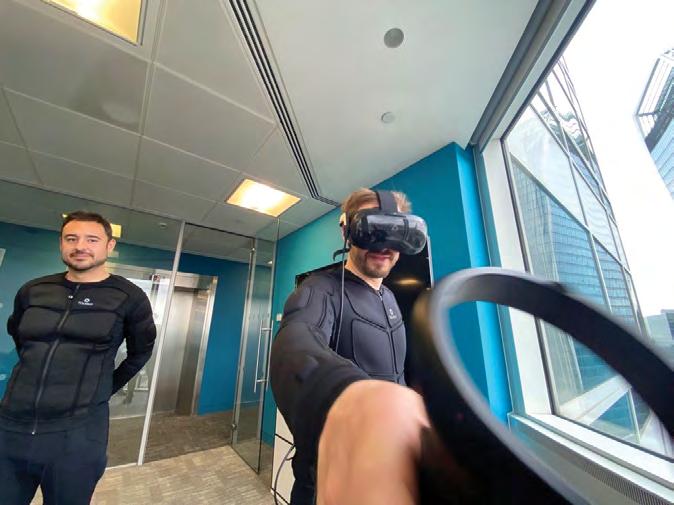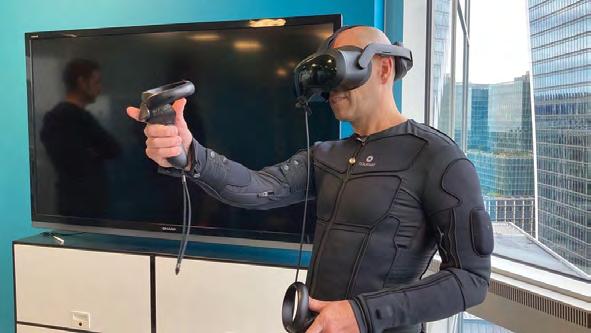
6 minute read
Next-Gen CloudXR: Bring your engineering and construction projects to life
Mr Greg Demchak, Director of Digital Innovation Lab, Bentley Systems, explains the concept of the metaverse, and shares how the company empowers users by combining the capabilities of the its digital twin applications with NVIDIA’s powerful technology, including Omniverse.
The Singapore Engineer (TSE): The world’s 3D industries, including leading software companies such as Bentley Systems, are working towards building the metaverse – a massive shared virtual world. Could you provide an overview of the metaverse and briefly explain its possible impact on the Built Environment and engineering industries?
Mr Greg Demchak (GD): The ‘metaverse’ still needs to be defined. One interpretation is that there will be an interactive 3D digital version of the physical world, where people can interact with it, as they would with physical reality. The interactions are based not only on 3D graphics but also on other forms of multisensory input. From a physical infrastructure perspective, the metaverse version will require layers of interaction and accessibility that surface on a range of devices and user experiences. Public infrastructure, such as electric and water facilities, transit networks, train stations and airports need to have safeguards and be protected so that society is kept safe from bad actors operating in the metaverse. When we produce 3D models that fully match the exact condition of an airport or a tunnel or an electrical substation, security has to be considered. The metaverse allows people to have a fully immersed experience that provides a very visceral understanding of the space, in a way that you would not get by looking at a floor plan or a section or even by looking at photos on a web page. For this reason, there will be permissions and tight control over who can interact with critical infrastructure that is metaverse-enabled. Then you need to look at different use cases as well as the personas that will interact in the metaverse. For example, you might have a maintenance worker go to a facility and interact with a digital twin to obtain information about the physical location of the asset. You might also have designers and engineers who will want to augment the existing structure with sensor data and historical documentation. Regarding the possible impact on industries, because the metaverse is still being defined and does not really exist, I cannot point you to an example of how you can go and experience it today. But the potential impact is that a designer or an engineer would be able to interact with buildings, with infrastructure and with architecture, in a very intuitive and natural way, to understand them. The metaverse is fundamentally about multisensory experiences of space. When we introduce spatial audio to a metaverse experience, you are able to hear sound in a 3D soundscape. So, the metaverse becomes a new communication medium, as was radio, television, and the Internet. As Marshall McLuhan said, “The medium is the message”, and the impact of the medium is larger than any message that is sent through that medium.
TSE: What is Bentley Systems’ contribution to the creation of the metaverse?
GD: Our contribution is that we want to enable our users to get more value out of their investment in 3D modelling. Many are already producing veryrich, highly detailed 3D models. And they are making amazing photogrammetry meshes of their environments, assets, and cities. Our users’ business is to produce high-quality 3D models and photogrammetry. We already have access to a huge amount of 3D content and our contribution is to say, “How can we make producing models as easy as possible? How can we empower our users to take their 3D models and photogrammetry captures into a metaverse experience so that, with one click, you can walk around an asset with a full-immersion VR headset?” Our contribution is to make it as easy as possible, and without any loss in engineering fidelity, to get that content into what we call an ‘intuitive metaverse experience’.
Mr Greg Demchak
TSE: How can 4D visualisation benefit from using NVIDIA Omniverse powered by iTwin?
GD: You can take the 4D sequence from any Bentley SYNCHRO model and export it to USD (universal scene definition) which is a file format that Pixar developed. It contains the mesh geometry, the animation data and the metadata. Via an export service API that we have written, a user can transfer all the information of that SYNCHRO model into other platforms. In this case, we are using USD to get the geometry and SYNCHRO animation into NVIDIA’s Omniverse, which is a platform that NVIDIA developed. The platform generates high-qual-
ity, photorealistic renderings of scenes – 3D models, engineering models and infrastructure. It creates photorealistic renderings of the 4D model. We have developed an application on top of the Omniverse platform, called LumenRT for Omniverse, that can read directly from a SYNCHRO instance, and then automate the whole extraction of that USD format into this app on top of LumenRT for Omniverse. Once it is in that application, a user can set up camera animations, turn on and off geometry, add additional content, play with the lighting and change the materials. Basically, you are upgrading the materials to be more photorealistic. Then you can produce a very high-quality visualisation.
TSE: Can you explain what NVIDIA CloudXR is and how NVIDIA CloudXR introduces new ways of working, while preserving and elevating existing workflows for design and building?
GD: CloudXR is how the rendering of large 3D models is removed from the local hardware of a laptop or computer and put in the cloud. CloudXR primarily targets XR devices, such as a HoloLens or an Oculus Quest, or other popular VR headsets. This is necessary because you are unable to load these large 3D models into an Oculus Quest 2. They are simply too large and will take up too much memory. To experience these large engineering models, you have to move the rendering off the device and stream the graphics into the device. From a user perspective, they will not notice the difference, unless the server is far away. The key here is that you are taking the rendering off the device and streaming that content. It is very similar to how Netflix and video streaming works. You are not downloading the whole film onto your device. You are streaming the graphics from a server. What CloudXR lets you do is run your app on CloudXR, make a connection to that app through your device, and then stream the graphics into the device.

Testing immersive sensory experiences with TeslaSuit and HTC Vive.
With full spatial audio and haptic feedback, metaverse becomes a new communication medium.
TSE: Any other information that you would like to provide?
GD: What we are also working on is an internal development that allows you to read complex 3D models through the Bentley iTwin platform into the Unreal Game Engine. You will be able to achieve very high frame-rate experiences of these complex 3D models using our plugin for Unreal Game Engine. With that, we can deploy it into a wide range of devices – everything from the Oculus Quest to the Varjo to the Pico, to the HoloLens 2. For use, it is important to be open and agnostic to whatever hardware our users are comfortable with. That is a principle of the metaverse that we definitely embrace – open and not tied to any one piece of hardware or user experience. That is also how Bentley thinks about the iTwin platform. You can synchronise 3D models from just about any common CAD format, and once it is there, we can then extend that 3D model to any device and not be constrained by file formats.





